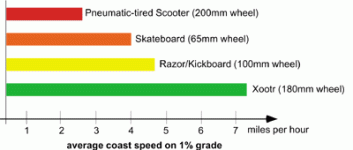Lock
100 MW
Lately I have been trying to understand bearings...
There are lots of references buried in ES threads about bearings (problems eg spacers) but I am a bit surprised to see that the list of threads w/bearings in the title barely fills one screen...
EVen though my interest is EV-related, my readings (off-ES) so far have been about applications w/RPMs to 30K and EVen 40K...
Also, bearings "immersed" in hostile environments, exposed to salt water and grit whatever while most of the ES tappity-tap seems about bearings "protected" inside motors and wheels that are isolated inside hub motors or elevated above road slop on axles that are a foot or more off the ground...
I am suspicious of all things "Made in China" (all aboard the Good Ship ES can relate, right?) and although I read about stuff here like Clyte using bearings with balls and good to go for a "lifetime", are they really (stock, made in China) really the most energy efficient?
No ES threads about ABEC numbers. ABEC versus "swiss". Permanent seals versus removeable. Ceramics. Oil versus grease options...
"Lithium" is a perennial subject on ES these daze... but in batts and not in grease? Versus for example graphite?
EVen ambient temps below 0°... Probably not a factor after the first few tens of thousands of revolutions?
Any ES ppl whose life revolves around bearings? (Sorry, couldn't resist but actually in my view you all do!)
but actually in my view you all do!)
Pls. post your thoughts, comments and links? Myself, I am only interested in the best performing* bearings money can buy today.
tks
lOcK
*Performance. Yah, subjective, I know...
There are lots of references buried in ES threads about bearings (problems eg spacers) but I am a bit surprised to see that the list of threads w/bearings in the title barely fills one screen...
EVen though my interest is EV-related, my readings (off-ES) so far have been about applications w/RPMs to 30K and EVen 40K...
Also, bearings "immersed" in hostile environments, exposed to salt water and grit whatever while most of the ES tappity-tap seems about bearings "protected" inside motors and wheels that are isolated inside hub motors or elevated above road slop on axles that are a foot or more off the ground...
I am suspicious of all things "Made in China" (all aboard the Good Ship ES can relate, right?) and although I read about stuff here like Clyte using bearings with balls and good to go for a "lifetime", are they really (stock, made in China) really the most energy efficient?
No ES threads about ABEC numbers. ABEC versus "swiss". Permanent seals versus removeable. Ceramics. Oil versus grease options...
"Lithium" is a perennial subject on ES these daze... but in batts and not in grease? Versus for example graphite?
EVen ambient temps below 0°... Probably not a factor after the first few tens of thousands of revolutions?
Any ES ppl whose life revolves around bearings? (Sorry, couldn't resist
Pls. post your thoughts, comments and links? Myself, I am only interested in the best performing* bearings money can buy today.
tks
lOcK
*Performance. Yah, subjective, I know...





